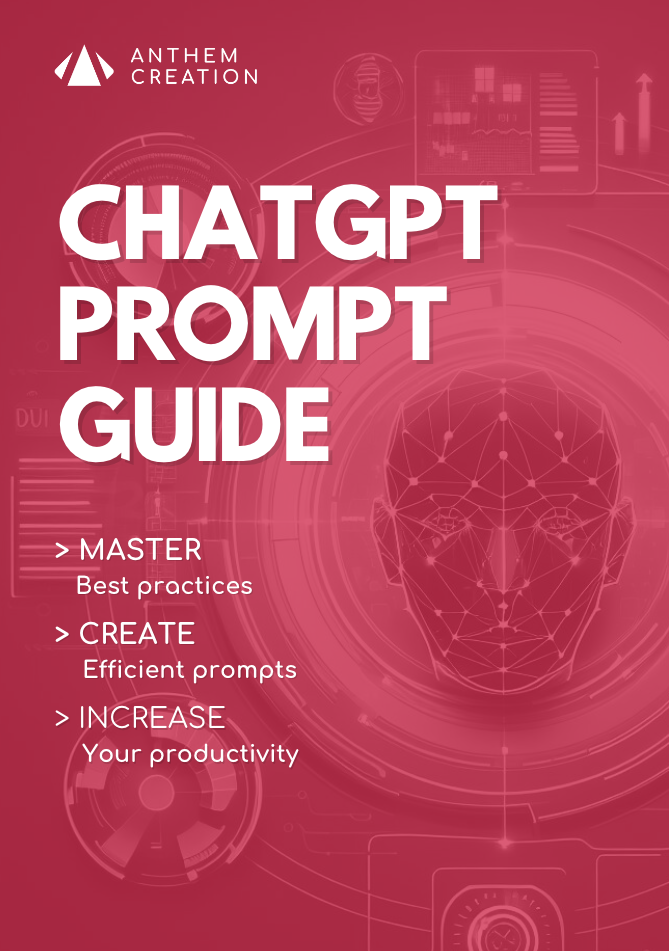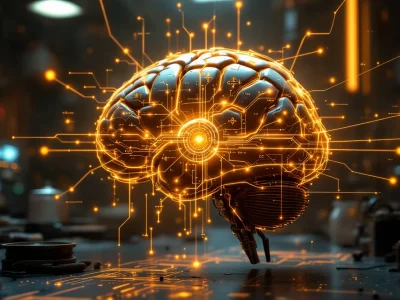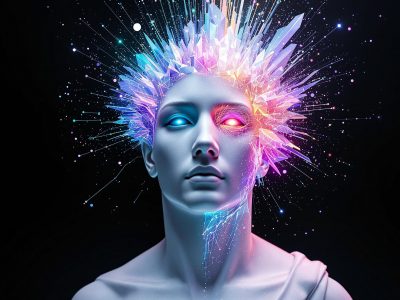When ChatGPT drafts an email in three seconds or Midjourney generates stunning visuals in just a few minutes, the temptation to see AI as merely a shortcut is strong.
But this utilitarian perspective misses the crucial point: the true promise of AI lies in its ability to free our minds from repetitive tasks, allowing us to explore entirely new intellectual territories.

AI isn’t here to lighten our workload—it’s here to radically transform what we define as work.
This cognitive liberation paves the way for a complete redefinition of our ambitions. Take, for example, medical diagnostics: AI doesn’t replace the doctor; it allows them to spend more time listening to the patient, analyzing complex cases, and innovating new therapies.
It’s a paradigm shift, where automating tasks becomes a springboard to more ambitious, more human, and more transformative goals.
Augmented Creativity
In creative studios, research labs, or classrooms, AI now enables us to accelerate exploratory phases and consider hypotheses that we would never have had the time to test before.
Where we used to settle for a handful of ideas, we can now explore hundreds and then focus our human intelligence on perfecting and implementing them.
This creative amplification pushes artists to reinvent their relationship with technology. Instead of fearing replacement, they discover new ways to express their vision by engaging in a dialogue with the machines.
Creative professions are evolving in the face of generative AI—not by disappearing but by reinventing themselves and embracing a greater artistic ambition.
The Example of Architects
Architects who integrate AI into their creative process no longer settle for drawing a few building variants.
They can now generate and analyze thousands of possible configurations, assessing their environmental impact, resistance to natural disasters, and cultural relevance.
The result? Bolder, more sustainable, and better-adapted buildings that meet human needs. The architect does not do less—they do more, they do better, and with greater significance.
Education Transformed
Concerns about students using ChatGPT for their assignments mask a more nuanced reality.
AI doesn’t spell the end of learning, but rather the end of a certain type of learning based on memorization and regurgitation.
Visionary teachers have understood this: the future belongs to those who know how to ask the right questions, guide the AI, and evaluate its results.
When memorization becomes optional, deep understanding becomes essential.
This transformation calls for a new kind of educational ambition. Instead of training students to solve known problems, we must develop original thinkers capable of defining future problems and orchestrating multiple intelligences (human and artificial) to solve them.
The art of advanced prompts with ChatGPT perfectly illustrates this new metacognitive skill: knowing exactly what to ask and how to ask it to achieve optimal results.
Ethics as a Compass
The massive automation enabled by AI frees up our time and cognitive resources. This liberation confronts us with increased moral responsibility: what will we do with this new capacity?
Colossal challenges like climate change, global inequality, or health crises now demand our full attention.
Entrepreneurs in Silicon Valley are beginning to grasp this dimension. Sam Altman, CEO of OpenAI, regularly emphasizes that the goal of GPT is not merely to automate human work, but to augment our collective ability to solve humanity’s greatest challenges.
This more ambitious vision of AI as a moral catalyst urges us to reconsider our priorities. If AI can take care of routine tasks, our ambitions should rise to nobler, more transformative objectives better aligned with our deepest values.
Beyond Productivity
The most revolutionary promise of AI is not increased productivity, but a complete redefinition of what it means to “work.”
When machines are able to carry out all repetitive and predictable tasks, human labor can finally focus on what truly makes us human: empathy, creativity, ethical judgment, and complex collaboration.
This metamorphosis of work demands renewed ambition. Leading organizations are no longer content to use AI to do the same work faster—they are redefining their goals, transforming their structures, and cultivating new human abilities.
New Territories for Human Ambition
AI is opening up unexplored avenues for human ambition. Scientists can now use AI models to discover new drugs at previously unimaginable speeds.
Ecologists are deploying intelligent sensor networks to monitor and protect entire ecosystems. Artists are collaborating with algorithms to create aesthetic experiences of unprecedented complexity.
These pioneers share a conviction: AI is not an end in itself, but a tool of exploration that lets us expand our ambitions well beyond traditional boundaries.
Ultimately, AI confronts us with a fundamental question: What is our true ambition as a species? Do we simply want to work less, or do we want to accomplish extraordinary things?
AI does not determine our ambition—it reveals it.
This technology gives us a unique choice: to use this power to rest on our laurels, or to go further.
History will remember AI as a turning point, not because it replaced humans, but because it revealed the dizzying scope of our collective potential. It’s up to us to seize this opportunity and deliberately aim higher.
FAQ
Will AI really eliminate jobs or create more?
The answer is nuanced. AI is transforming the job market rather than destroying it. It automates certain tasks while creating new jobs (prompt engineers, AI ethicists, explainable AI specialists).
The history of technological revolutions shows they generally create more jobs than they eliminate, but the transition can be difficult and requires skill adaptation.
How can I use AI to “aim higher” in my daily work?
Start by identifying the repetitive tasks that consume your time without adding creative value (drafting standard emails, preliminary research, document formatting).
Automate these with AI, then reinvest the time you save into higher-value activities: strategic thinking, innovation, developing deeper human relationships, or acquiring new skills.
The goal is not to work less, but to focus your work on more meaningful aspects.
Isn’t there a risk that AI will make us intellectually lazy?
This risk exists, but it is not inevitable. Everything depends on how we approach this technology. If we use it as a crutch to replace our thinking, we will weaken ourselves. If we use it as a partner to stimulate our thinking, we will grow stronger.
The key is to maintain regular practice of critical thinking, to question AI’s results, and to view it as a tool to amplify our abilities, not replace them.
How should schools and universities integrate AI into their teaching?
Progressive educational institutions are no longer trying to fight against AI but are integrating it into their pedagogy. They teach students to use these tools critically, to understand their limits and biases.
The focus is shifting from memorization to creative problem-solving, critical evaluation of sources, and the ability to ask relevant questions.
AI becomes a subject to study in itself, as well as a personalized learning tool that frees teachers to concentrate on intellectual guidance rather than rote information delivery.
Which human skills will remain valuable in the age of AI?
Uniquely human skills will become increasingly valuable: emotional intelligence, original creativity, ethical judgment, critical thinking, solving complex and interdisciplinary problems, collaboration, and leadership.
On top of that, meta-skills like adaptability, continuous learning, and the ability to navigate uncertainty will be in high demand.
The combination of these human qualities with strong command of AI tools will define the most sought-after professional profiles of the coming decades.
How can we prevent AI from worsening social inequalities?
This legitimate concern requires action on multiple levels. Governments must invest heavily in digital skills training for all.
Tech companies need to develop accessible AI models and intuitive interfaces that don’t require advanced technical expertise.
Open-source initiatives and local AI models can democratize access to the benefits of this technology. Finally, regulation must ensure transparency and fairness in the deployment of systems.
AI NEWSLETTER
Stay on top of AI with our Newsletter
Every month, AI news and our latest articles, delivered straight to your inbox.

CHATGPT prompt guide (EDITION 2024)
Download our free PDF guide to crafting effective prompts with ChatGPT.
Designed for beginners, it provides you with the knowledge needed to structure your prompts and boost your productivity
With this ebook, you will:
✔ Master Best Practices
Understand how to structure your queries to get clear and precise answers.
✔ Create Effective Prompts
The rules for formulating your questions to receive the best possible responses.
✔ Boost Your Productivity
Simplify your daily tasks by leveraging ChatGPT’s features.
Similar posts
5 best AI trends in 2025 : prepare for change
Artificial intelligence is no longer just progressing – it’s fundamentally redefining our society. In 2025, we will reach a decisive milestone where AI will become deeply integrated into every aspect …
AI in education in 2025 : A pedagogical revolution or ethical challenge?
Increasingly sophisticated tools are overturning learning methods, transforming classroom management and reinventing vocational training, while raising important ethical and pedagogical questions. AI as an engine for massive learning personalization Artificial …
AlphaEvolve: Scalable, autonomous AI that pushes back the frontiers of science
Imagine an artificial intelligence capable of making scientific discoveries entirely on its own. An AI that doesn’t just follow instructions, but constantly evolves, constantly improves, and generates breakthroughs that even …


